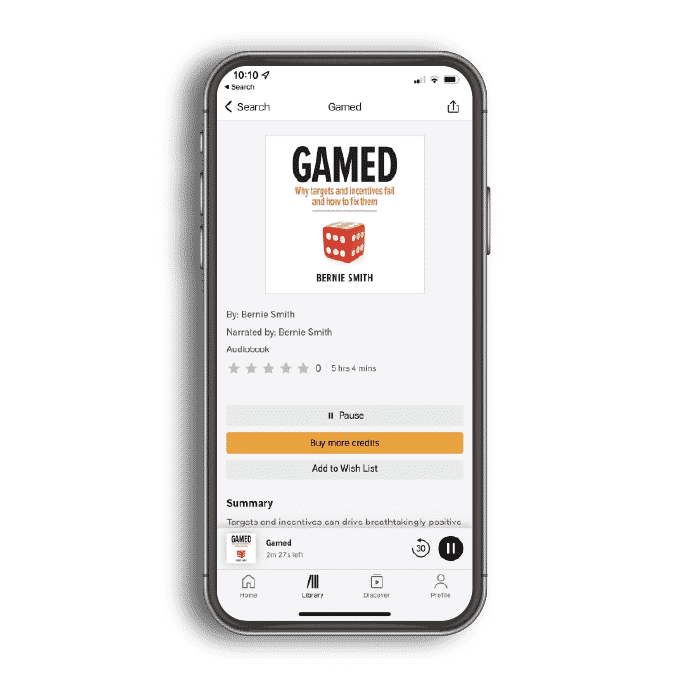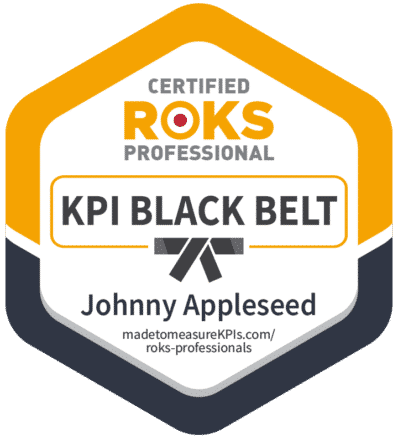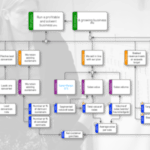Why we need to pay attention to performance target problems
From the moment we can first walk and talk. We are motivated, controlled and rewarded using a combination of targets and incentives. Which parent hasn't used a sticker chart in a desperate attempt to get the kids to cooperate with them?
Targets and incentives are so deeply embedded in a modern society that many of us don't even notice that they are core to almost every aspect of our lives. That would be fine if our KPI targets and performance incentives worked properly, but there is plenty of evidence every time you open a news website that they often don't work very well at all. Here's a selection of KPI target problems from the news....
- Ex-Audi boss stands trial over 'dieselgate' scandal in Germany - fallout from Volkswagen Audi manipulation of EPA emissions tests.
- Lloyds profits nearly wiped out by £1.8bn PPI hit - Financial mis selling scandal driven by agressive sales targets for highly profitable 'payment protection insurance' products.
- ...how some funds hide poor performance that can derail your retirement - A lack of rules around reporting and intense commercial targets drive jaw-dropping liberties when it comes to the reporting of fund performance.
A quick refresher on what targets are...
What is a KPI target?
It is when we compare KPIs with targets that we start to make a value judgement about whether we are performing well or poorly.
If my bathroom scales tell me I weigh 80 kg, my reaction would be shaped by my personal target. Weighing 80 kg when my target is 85 kg might be good news, less so if my target is 60 kg.
The target provides the context for reviewing our performance, as reported by our KPI values. When we have KPI target problems, we often end up with serious organisational problems.
Your KPI target problems might be killing your organisation. Here's why...
There is a high chance that dysfunctional KPI targets and incentives are seriously impairing the performance of your organisation. The big challenge with KPI target and performance incentive problems is that they are often silent and invisible but there are a few symptoms that should make you want to dig deeper...
- High team attrition
- Lots of management time spent on performance target disputes
- Disappointing organisational performance
- Missed targets and goals
- Team apathy and cynicism
- Rule breaking, use of loopholes and even lawbreaking
The first step in curing KPI target problems is to diagnose the condition. The good news is that many of the problems we see come up repeatedly, across many types of organisation. We can learn from the failures of others. (For the background stories behind where these diagnosis codes come from, check out my book "GAMED: Why targets and incentives fail, and how to fix them").
The performance target problems listed below are the result of reverse-engineering dozens of high-profile case studies of KPI target design failure.

Learn how to design targets and incentives that really work


The 10 most common KPI target problems, with examples
1. 'All or nothing' KPI targets
Description
There is a single tier. You either achieve the target or you do not.
Why this is a KPI target problem
A target will only act as a motivator if an individual feels they are close enough for it to be a real prospect. In any organisation there will be a spread of performers. Having an `all or nothing' target means that a substantial part of any population will have no prospect of winning.
If the person is close to winning, the opposite problem may occur, creating extreme motivation and increasing the risk of rule bending, breaking, or law-breaking.
Example
Research by Michael Ahearne, working with a US financial services firm, showed that having multiple levels of targets significantly improved the performance of `core (middle) performers' within an organisation, with core performers showing a significant uplift from the use of three target tiers, compared with one or two tiers.
2. Incomplete KPI target rule definition
Description
This performance target problem is where the rules for a target do not fully cover all situations.
Why this is a KPI target problem
When rules are not complete, it is possible to game the targets to win without delivering the intended positive outcomes.
Example
During the Covid-19 pandemic, the UK government promised '100,000 tests per day'. In an attempt to hit this target, the government changed the calculation method to be based on the number of test kits dispatched, rather than used. This was followed by reports that requests for test kits were supplied with triple the requested quantity, moving the government towards the 100k target without a meaningful real-world benefit.
3. KPI target design input bias
Description
Certain inputs are excluded, by design, to improve the reported results.
Why this is a KPI target problem
The measures used to assess whether the target has been hit will be misleading, leading to a situation where a target may be hit and an incentive given, when the real-world performance does not justify it.
Example
In the UK, in some schools it is not uncommon to prevent 'A-level' students from sitting public exams if they are expected to perform poorly or fail. Using this kind of design input bias, schools are able to protect or maximise their average grade performance.
4. Excessively high KPI target bar
Description
A target is set at an unrealistically high level.
Why this is a KPI target problem
This situation can lead to rapid disengagement from the target recipients or to rule/law breaking.
Example
When a leading UK supermarket, Tesco, set aggressive 2014 profit targets, a whistle-blower described how the senior management team viewed those targets as 'insurmountable'. This perception may have led to the company being forced to admit deliberately overestimating annual profits by £250 million.
5. Intentionally low KPI target bar
Description
The threshold is set to an unrealistically low level.
Why this is a KPI target problem
A deliberately low target threshold can lead to a reduction in real-world performance, as the target is `too easy' and does not require high performance levels to meet or exceed it.
Example
Exam grade inflation', where the proportion of students achieving top grades increases over time, is thought to be driven by the competitive pressures on examination boards. Put simply, easier curricula and examinations attract the custom of more schools — creating a sustained incentive to lower the bar' when it comes to exam difficulty.
6. Weak/no link to intended between target and positive outcome
Description
There is no obvious connection between the targeted KPI and the intended outcome.
Why this is a KPI target problem
When there is no clear link between the target and positive outcomes, it can quickly lead to cynicism, frustration, and disengagement.
Example
In the UK ambulance service, for over 40 years an A8' target was used for the most serious calls. The target was that 75% of life threatening' calls be attended within 8 minutes. There was no medical basis for the 8-minute target, but plenty of pressure to achieve that target on a regular basis, leading to high levels of cynicism and disillusionment amongst those tasked with hitting that target.
7. Arbitrary KPI target selection
Description
There is no obvious connection between the KPI target value and the intended outcome.
Why this is a KPI target problem
Arbitrary target selection can lead to cynicism, frustration, and disengagement.
Example
At the core of the Wells Fargo banking scandal was the Going for Gr-eight' target. The goal was to cross-sell eight products to every customer. When the architect of this target, CEO Dick Kovacevich, was asked how he came up with the target of cross-selling eight products, his reply was It rhymes with GREAT!'
8. Individual KPI target and organisational success not aligned
Description
This performance target problem occurs when the targets set for an individual will not drive outcomes that are beneficial for the organisation.
Why this is a KPI target problem
Targets that only benefit the target-recipient will fail to move the organisation towards their intended objectives. In the worst situation the cost of rewards offered to individuals, combined with a lack of tangible benefit, can fatally damage an organisation.
Example
Incentivising computer programmers based on maximising lines of code written can lead to inefficient and difficult to maintain computer code. The coder can hit the target, but the resulting software may not deliver the best outcome for the organisation using it.
9. Lack of pace-setting KPI targets
Description
This KPI target problem occurs when the interval between target reviews is too long, leading to a loss of motivation.
Why this is a KPI target problem
Research shows that weaker performers see an increase in performance from more frequent target-incentive reviews. By not using pace-setting targets we sacrifice the potential benefit.
Example
Elite long-distance runners have long known that it is no good waiting until the end of a race to find out if they were running at the best pace. Lap times, pace calculators, and constant feedback are essential to achieving their best performance. The same applies to any human endeavour. Prompt, accurate, and frequent feedback on performance consistently delivers higher levels of performance.
10. Inappropriate KPI targets timescale
Description
The target review frequency is not appropriate to influence and control the thing being measured.
Why this is a KPI target problem
A long review interval, say an annual review, for a time-sensitive activity (for example customer interaction skills) reduces the benefit from the target-incentive approach, as it breaks the feedback-response loop.
Example
In the UK, state schools receive a government quality assessment called an `Ofsted rating'. These assessments can have a significant impact on parents' choice of schools. The Ofsted assessment frequency is approximately 4 years. Much can change in 4 years, including the leadership and teaching staff. Choosing a school based on a 4-year-old rating could be compared to driving your car based on what you were seeing 10 minutes ago.KPI

Radically improve your KPI targets and incentives with the ROKET-DS approach
The KPI target problem types listed in this post are part of a larger diagnostic tool called the ROKET-DS diagnostic. That diagnostic tool is, in turn, 'Step 0' of the ROKET Design System (ROKET-DS), a step-by-step method to take you from your goals through to fully implemented and tested KPI targets and performance incentives. To learn more about this system you can buy a copy of GAMED, sign up for the on-demand online course, better still, join the next KPI online Black Belt Programme.











